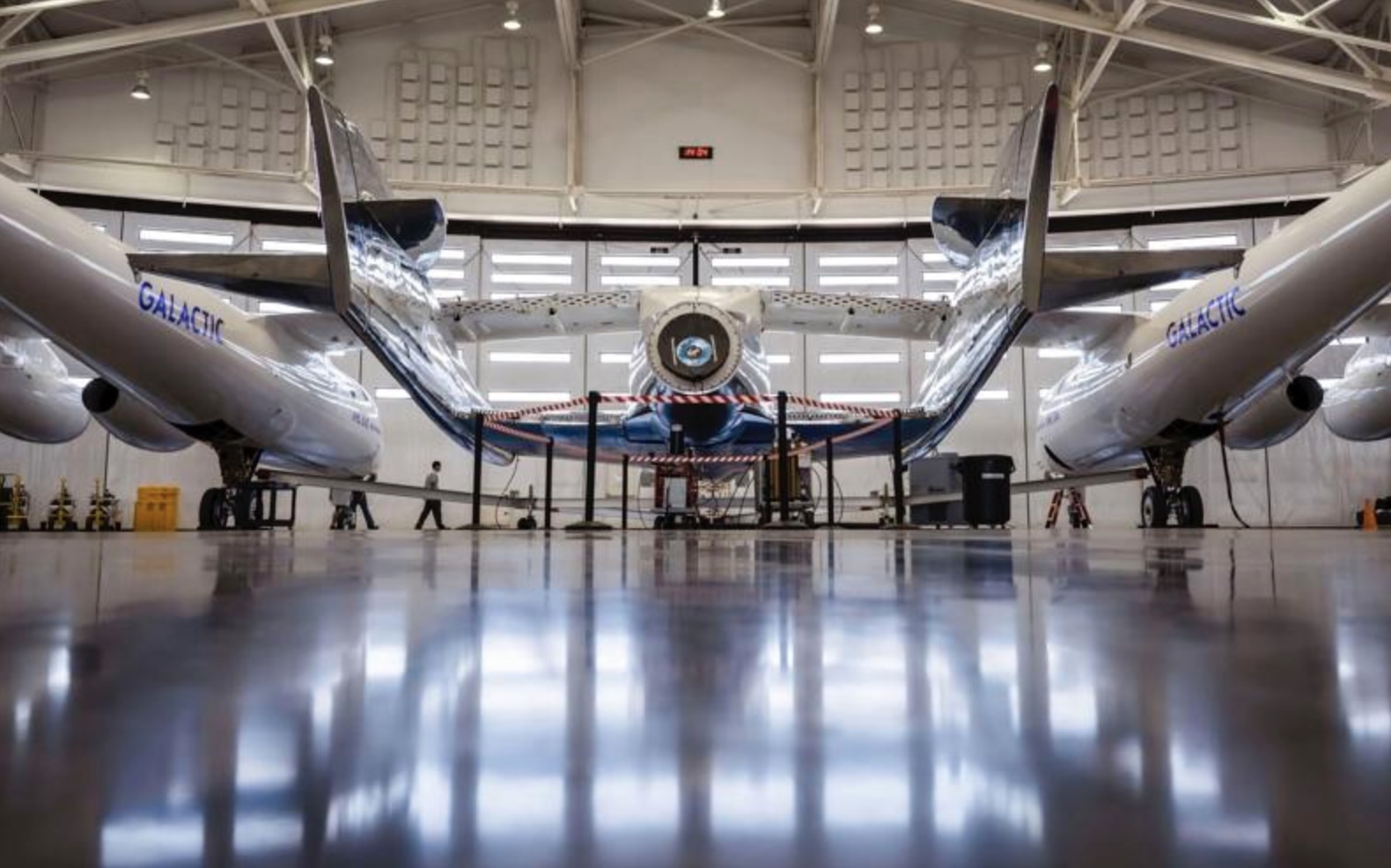9.05.2024

VMS Eve, Virgin Galactic’s mothership, with the six-passenger VSS Unity spaceship attached to its wings, sits inside the hanger at Spaceport America in southern New Mexico,Chancey Bush/Journal
Virgin Galactic plans to fly to space 125 times per year beginning in 2026 while scaling up its operations at Spaceport America in southern New Mexico .
Virgin Galactic made the announcement while reporting financial results for the first quarter that ended March 31. The company’s revenue was $2 million in the quarter, driven by commercial spaceflight and future astronaut fees, compared to about $400,000 the first quarter of 2023, according to a news release.
Virgin Galactic is planning a commercial spaceflight next month. It has said it will then pause spaceflights from Spaceport America and focus on building its next generation of Delta space ships.
“We are planning to fly the last commercial flight VSS Unity on June 8, taking a researcher and three private astronauts to space and delivering an incomparable and life-changing experience to each of them,” Michael Colglazier, Virgin Galactic CEO, said during a conference call with investors and the media Tuesday. “This will mark our seventh commercial flight and 12th spaceflight in total. Again, demonstrating the Virgin Galactic spaceflight system is safe, reliable and repeatable with an experience beyond compare.”
There also is a plan to increase flight frequency for Virgin Galactic’s mothership, Eve. Doug Ahrens, Virgin Galactic Holding chief financial officer, said that would be a “game changer.”
“Flying Eve three times a week means we have the capacity to conduct approximately 125 flights per year, allowing for potential weather or operational inefficiencies at that pace,” Ahrens said. “With six seats per spaceflight, we plan to fly 750 astronauts to space annually with our first two Delta ships. ”
Virgin Galactic expects to be able to achieve annual earnings of $450 million because of the increase in space flights.
“This is a sizable business that can be achieved (with) the mothership we have, plus the addition of the first two Delta class spaceships,” Ahrens said. “We’ve shared with you previously that we expect to see contribution margins about 75% for each space flight. This is the margin we project after accounting for the variable cost of each flight, such as rocket motor, fuel, hospitality expenses for the astronauts, etc. This contribution margin will be more than enough to cover the fixed costs of running business, leading to meaningful operating cash flow.”
Ahrens said profits can be reinvested to expand the company’s fleet and drive additional growth. Virgin Galactic plans to build additional Delta ships at a recurring cost of $50 million to $60 million each.
“The cost of our future ships are so low because the designs are already done, the tools will already have been built, the supply chain will be in place and our spaceship assembly factory will be up and running,” Ahrens said. “These are the investments we are making right now, which gives us infrastructure needed to further drive substantial growth. Our intentions are to continue to expand at Spaceport America and then to add more space ports in other locations around the world.”
Ahrens said Virgin Galactic estimates that each operational spaceport can generate over $1 billion of revenue annually.
He said total operating expenses in the first quarter of the year were $114 million, compared to $164 million the prior year.
Ahrens said free cash flow was negative $126 million in the first quarter, compared to negative $139 million from the same period last year. He said the balance sheet remained strong with $867 million in cash, cash equivalents and marketable securities.
“Moving to our projections, revenue for the second quarter of 2024, is expected to be approximately $3.5 million. Forecasted free cash flow for the second quarter of 2024 is expected to be in the range of negative $110 million to $120 million,” Ahrens said.
Colglazier said the Delta schedule remains on track for commercial service in 2026.
“At the same time, we remain committed to our long-term, high-growth business model — scaling operations at Spaceport America with a fleet of fortified spaceships, followed by the creation of fully utilized space ports and continuous operations from multiple locations around the world,” he said.
News of the increase in flights was welcomed at Spaceport America, where Virgin Galactic is a primary tenant. Last year, Virgin Galactic laid off about 70 New Mexico employees to focus on building the Delta spaceships.
Scott McLaughlin, executive director of Spaceport America, said the facility’s infrastructure and operations were designed for Virgin Galactic’s proposed initial flight rate of up to 125 flights a year. He said in the meantime, Spaceport America will continue to see increased activity from other customers.
“We look forward to this activity and the significant economic impact and additional jobs this will create,” McLaughlin said.
Colglazier said Virgin Galactic maintains design authority for its Delta spaceships and leverages the manufacturing and engineering expertise with a few key industry partners.
The company is targeting a date in 2028 to deliver its next-generation mothership. Virgin Galactic has a mothership that carries the rocketship to around 50,000 feet, at which time the rocketship breaks away from the mothership and ignites its rocket motor to shoot into suborbit, according a news release.
“We expect to follow a similar approach with our next mothership program,” Colglazier said.
Colglazier said the timing enables Virgin Galactic to manage its existing capital confidently, which in turn sets it up for long-term success.
“Importantly, our growth strategy remains the same,” he said. “To scale our commercial space travel business first by adding ships to our fleet in New Mexico, and then expanding to additional spaceports in excellent locations around the globe.”
Quelle: Albuquerque Journal

